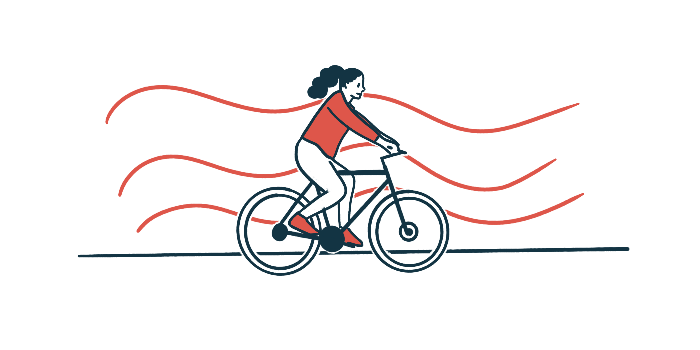Cycling tour of Canada ‘profoundly’ eased man’s Parkinson’s symptoms
Ride also supported benefits of intense exercise for physically active patients

A man with Parkinson’s disease saw an easing of his motor and nonmotor symptoms and better fitness after taking part in Spinning Wheels, an 85-day, cross-country bike tour of Canada supporting people with the neurodegenerative condition.
Steve Iseman, 57, cycled 7,850 km (nearly 5,000 miles) from Canada’s west to east coast, helping researchers to better understand how high-intensity exercise could benefit people with Parkinson’s, particularly those who already exercise regularly.
Iseman, who was diagnosed with the disease at age 48, experienced a 44% drop in his Parkinson’s motor symptoms — as seen in a post-tour score on the Unified Parkinson’s Disease Rating Scale (UPDRS) part III of 26 points, compared with a starting score of 46. Higher scores on this scale indicate more severe motor symptoms.
‘Quite powerful to see the benefit of exercise’ with Parkinson’s disease
“It’s anecdotal, but it’s quite powerful to see the benefit of exercise,” Philip Millar, PhD, an associate professor in the department of human health and nutritional sciences at the University of Guelph in Ontario, said in a university press release.
“Typically, returns start to decrease at a certain amount of time or intensity, but in Iseman’s case, there were profound improvements in motor symptoms in a person already doing high levels of exercise,” Millar added.
Iseman’s case was described in “Physiological and clinical responses to cycling 7850 km over 85 days in a physically active middle-aged man with idiopathic Parkinson’s disease,” published in Physiological Reports.
In addition to medications and surgery, a range of Parkinson’s treatment options can help patients keep disease symptoms under control. Engaging in regular exercise has been shown to help maintain mobility, improve balance and gait, and ease nonmotor symptoms.
But questions remain as to whether those who “already engaged in regular physical activity can achieve additional benefits with further increases in the exercise dose above current recommendations,” the researchers wrote.
Millar’s team assessed Iseman during visits before and after the Spinning Wheels tour, using tests that included UPDRS part III, a standard motor evaluation scale, as well as those evaluating his muscle strength, balance, gait, and cardiovascular response to exercise.
Following Iseman’s journey was “a unique opportunity to see someone do an exercise regime that is far-and-above what would be prescribed or what the average person would do,” Millar said.
Iseman rode an average of nearly 108 km a day, at an average speed of 25.1 km
After his idiopathic (unknown cause) Parkinson’s diagnosis in 2014, Iseman was prescribed levodopa, carbidopa, Eldepryl (selegiline hydrochloride), Mirapex (pramipexole dihydrochloride), Comtan (entacapone), Gocovri (amantadine), and the antidepressant mirtazapine.
He worked to stay active and engaged in aerobic exercise five times per week for a total of about five hours, before joining Spinning Wheels’ coast-to-coast ride in support of Canadians living with Parkinson’s. The four-person tour, which included two other Parkinson’s patients and a disease caregiver (later joined by another caregiver), reported raising CA$120,000 (about $90,000).
He also co-founded Rigid Riders, a cycling club for people with Parkinson’s, in 2019.
Iseman rode his bike for 73 of the tour’s 85 days, covering an average of 107.5 km (about 66 miles) daily over an average of slightly more than four hours. His average cycling speed was 25.1 km (15.6 miles) per hour. His heart rate, measured over 30 days with a monitor, averaged 117 beats per minute.
Without changing his medications throughout the tour, Iseman “reported frequently skipping the evening dose of levodopa and carbidopa due to improved motor symptoms,” the researchers wrote. His weight remained constant at 71.7 to 71.9 kg (about 158 pounds).
His resting heart rate increased by nearly 50%, going from a slower-than-normal rate of 48 to a normal 71 beats per minute. Blood pressure did not change before the tour, but appeared normal in response to a handgrip exercise given after the tour.
His ability to generate power through knee extensions increased by 12% over the ride.
In addition to gains seen in the UPDRS part III, his score on the 16-item Parkinson Fatigue Scale decreased from 3.4 to 2.3 points, meaning he reported 32% less fatigue after the tour.
“These observations argue against a ceiling effect of aerobic exercise training on [Parkinson’s] motor symptoms,” the researchers wrote. “Future clinical trials should compare the efficacy of altering exercise intensity and duration for clinical and physiological adaptations in people with [Parkinson’s].”
While these observations come from a single case, “Iseman’s experience offers a motivating, forward-looking view of the improvements someone who’s newly diagnosed could experience,” Millar said.







